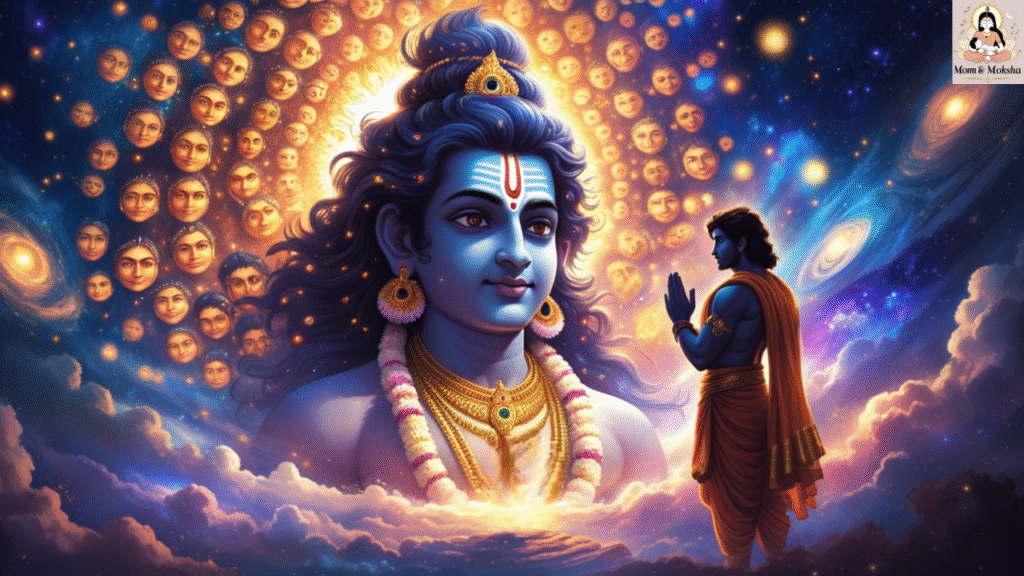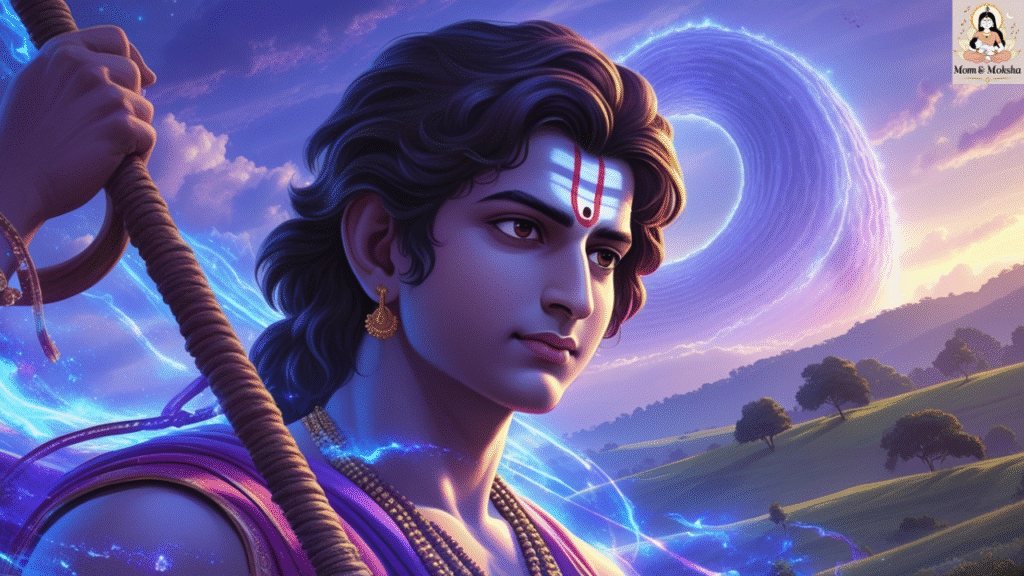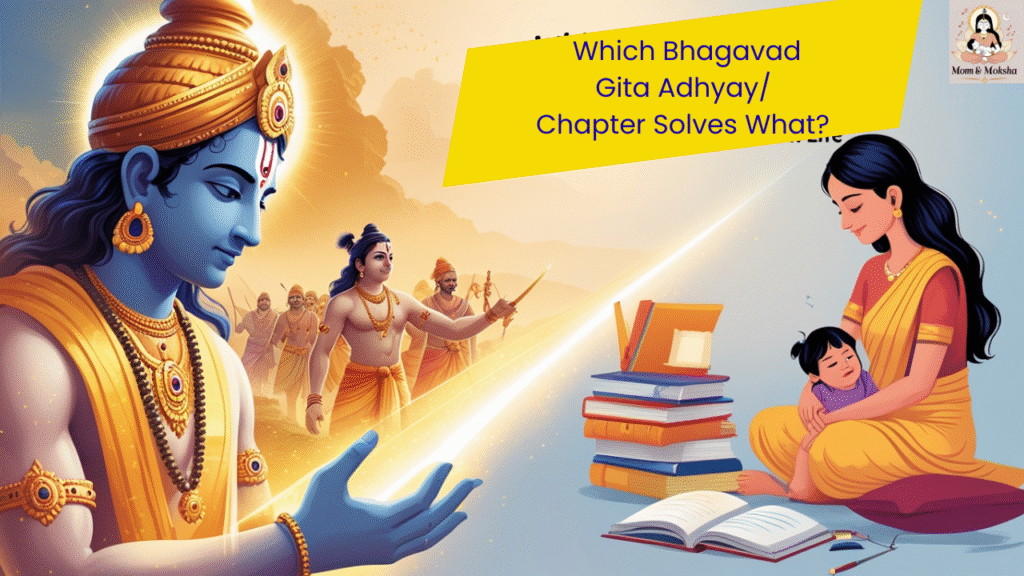Introduction
The Bhagavad Gita, often called the Song of God, is a timeless dialogue between Lord Krishna and Arjuna that offers wisdom for every stage of life. It is more than just a scripture—it is a living guide that addresses stress, confusion, identity, devotion, and liberation.
In the first part (Adhyay 1–9), Krishna walks us through the foundations of self-discovery, karma yoga, and devotion. If you haven’t read it yet, you can explore my detailed reflections here 👉 Bhagavad Gita Simplified | Divine Teachings from Adhyay 1–9 (Part 1).
Now, in the second half (Adhyay 10–18), the wisdom deepens. Krishna reveals His divine glories, the cosmic form, the meaning of true devotion, the play of the three gunas, and finally, the highest truth of surrender. Together, these chapters form a living synopsis of Bhagavad Gita—a message that blends karma, bhakti, and jnana into a single path.
Through this part of the Gita, we begin to see why the importance of Bhagavad Gita in Hinduism is timeless, and how the importance of Bhagavad Gita in daily life remains relevant for students, moms, and seekers even today.
This blog is a simplified chapter-by-chapter journey through Adhyay 10–18, showing not only the philosophy but also the life lessons from Bhagavad Gita for modern life.
Adhyay 10: Vibhuti Yoga – The Yoga of Divine Glories
Emotion/Struggle: Doubt, lack of inspiration, feeling small
Key Quote: “I am the taste of water, the light of the sun and the moon, the syllable Om in the Vedas.”
(One of the most beautiful Bhagavad Gita quotes that shows God’s presence everywhere.)
Krishna lists His divine manifestations—He is the brilliance of the sun, the fragrance of the earth, the courage of the mighty, and the wisdom of the wise. This chapter shows the importance of Bhagavad Gita in Hinduism as it teaches us to see God not just in temples but in every part of creation.
💭 Modern Life Connection: When life feels ordinary, Krishna reminds us that the divine spark shines through every simple moment. Drinking water, watching the moon, or experiencing kindness—all are reflections of God’s presence.
🌸 Lesson for Moms & Daily Life: Turn small chores into worship—God is present in them.
✨ Practical Tip: Pause once daily to notice something divine around you.
👩👦 My Take: This chapter helped me see that my role as a mom is not small—it reflects divine strength.
Adhyay 11: Vishwaroopa Darshana Yoga – The Cosmic Vision

Emotion/Struggle: Awe, fear, surrender
Key Quote: “Behold, Arjuna, My opulence, hundreds and thousands of varied divine forms, of various colors and shapes.”
Krishna reveals His vast cosmic form—showing creation and destruction in one vision.
💭 Modern Life Connection: Our worries feel big until we realize the universe is infinitely larger.
🌸 Lesson for Moms & Daily Life: Trust the bigger plan even in chaos.
✨ Practical Tip: Whenever fear grips you, whisper: “I am part of a divine plan.”
👩👦 My Take: This chapter humbled me—I realized my struggles are small in the cosmic picture.
References: Bhagavad Gita on Gita Supersite (IIT Kanpur)
Adhyay 12: Bhakti Yoga – The Yoga of Devotion
Emotion/Struggle: Longing, love, surrender
Key Quote: “Those who worship Me with love, I deliver them swiftly from the ocean of birth and death.”
Krishna assures that devotion is greater than rituals or knowledge—pure love matters most.
💭 Modern Life Connection: In a world chasing perfection, God asks only for sincerity.
🌸 Lesson for Moms & Daily Life: Your love and care itself is bhakti.
✨ Practical Tip: Offer your daily work as devotion.
👩👦 My Take: I learned that bhakti is not about long rituals—it’s love in action.
Just like offering Tulsi leaves in puja symbolizes pure devotion, Bhakti Yoga reminds us that love is more important than ritual. (Read more here 👉 Tulsi Puja Importance & Tulsi Vivah)
Adhyay 13: Kshetra Kshetragya Vibhaga Yoga – The Field and the Knower
Emotion/Struggle: Identity crisis, confusion
Key Quote: “This body is called the field, and one who knows this body is called the knower of the field.”
Krishna distinguishes between body (temporary) and soul (eternal).
💭 Modern Life Connection: We define ourselves by roles, looks, or status—but our true self is beyond all.
🌸 Lesson for Moms & Daily Life: You are more than “just a mom” or “just a student.”
✨ Practical Tip: Repeat: “I am a soul on a journey.”
👩👦 My Take: This chapter gave me freedom from labels—I am eternal, not limited.
Parenting often makes us forget our own identity—but the Gita reminds us we are eternal souls, not just roles. (Related read 👉 Parenting Wisdom from the Gita & Vedas)
Adhyay 14: Gunatraya Vibhaga Yoga – The Three Gunas

Emotion/Struggle: Mood swings, habits
Key Quote: “The three modes—sattva (goodness), rajas (passion), tamas (ignorance)—bind the soul to the body.”
Our behavior and moods are influenced by these three qualities.
💭 Modern Life Connection: Calm days, restless days, lazy days—all come from the play of gunas.
🌸 Lesson for Moms & Daily Life: Awareness helps us rise above moods.
✨ Practical Tip: Choose sattvik foods, thoughts, and company.
👩👦 My Take: Knowing about gunas helped me understand my changing moods without guilt.
Adhyay 15: Purushottama Yoga – The Supreme Divine
Emotion/Struggle: Feeling trapped, seeking liberation
Key Quote: “This world is like a tree with its roots above and branches below.”
Krishna explains the difference between the eternal and the temporary.
💭 Modern Life Connection: Life can feel like endless cycles, but we are meant to seek higher purpose.
🌸 Lesson for Moms & Daily Life: Don’t get lost in chores or comparisons—see the higher goal.
✨ Practical Tip: Ask daily: “Is this leading me to peace or binding me more?”
👩👦 My Take: This chapter reminded me to rise above routines and focus on the eternal.
Adhyay 16: Daivasura Sampad Vibhaga Yoga – Divine vs. Demonic Qualities
Emotion/Struggle: Inner conflict, negativity
Key Quote: “Fearlessness, purity of heart, compassion—these are the divine qualities. Pride, anger, harshness—these are the demonic.”
Krishna explains divine vs. negative traits within us.
💭 Modern Life Connection: Daily choices decide whether we nurture light or darkness.
🌸 Lesson for Moms & Daily Life: Choosing kindness over ego makes parenting, studying, or work divine.
✨ Practical Tip: Journal nightly—“Which divine quality did I show today?”
👩👦 My Take: This chapter helped me shift focus from perfection to nurturing kindness.
Adhyay 17: Shraddhatraya Vibhaga Yoga – Three Types of Faith
Emotion/Struggle: Blind faith, confusion
Key Quote: “Faith is of three kinds, born of the modes of nature—sattvik, rajasik, and tamasik.”
Not all faith uplifts—its quality depends on our inner nature.
💭 Modern Life Connection: Intention matters more than ritual.
🌸 Lesson for Moms & Daily Life: True devotion is peaceful, not fearful.
✨ Practical Tip: Ask: “Does this belief uplift me or weigh me down?”
👩👦 My Take: I stopped comparing my rituals with others—realizing intention is the true essence of faith.
Adhyay 18: Moksha Sanyasa Yoga – The Final Teaching of Liberation
Emotion/Struggle: Doubt, longing for freedom
Key Quote: “Surrender all varieties of duties unto Me, and I shall deliver you from all sins. Do not fear.”
Krishna concludes with the ultimate teaching—surrender is the highest strength.
💭 Modern Life Connection: True peace comes not from control, but letting go.
🌸 Lesson for Moms & Daily Life: Stop trying to be perfect—do your best and surrender.
✨ Practical Tip: Whisper daily: “Krishna, I surrender this to You.”
👩👦 My Take: This chapter gave me the courage to let go—showing surrender is strength, not weakness.
🌺 Conclusion
Adhyay 10–18 of the Gita teach us to see divinity everywhere, trust the bigger plan, choose devotion, rise above moods, nurture divine qualities, and finally surrender. For moms, students, and seekers—these teachings are not ancient philosophy, but everyday wisdom for peace and strength.
The second half of the Gita (Adhyay 10–18) is a treasure chest of Bhagavad Gita Wisdom. It teaches humility, devotion, identity beyond the body, and the path to liberation. For modern readers, these chapters offer practical life lessons from Bhagavad Gita—for moms handling responsibilities, for students facing exams, and for anyone seeking peace in chaos.
✨ Best For:
- Moms balancing love and identity
- Students needing focus and values
- Professionals struggling with pressure
- Seekers desiring spiritual depth
The importance of Bhagavad Gita in Hinduism lies in its timeless relevance. Though spoken millennia ago, its words remain a guiding light. The importance of Bhagavad Gita in daily life is seen when its teachings help us deal with stress, doubts, and decisions. These chapters serve as a living synopsis of Bhagavad Gita, blending Karma, Bhakti, and Jnana into one unified path.
For students, these chapters offer invaluable lessons from Bhagavad Gita for students—detachment from results, focus on effort, and respect for knowledge. For families, it is a reminder of compassion, devotion, and dharma as guiding values.
As Krishna’s words echo through time, we continue to draw strength from Bhagavad Gita Quotes, finding clarity and comfort in them. Ultimately, the Gita does not remain a scripture of the past but a manual for modern life—teaching us how to live with balance, surrender, and inner freedom.
✨ Which of these chapters touched you the most? Share your reflections below—I’d love to hear your journey with the Gita.


